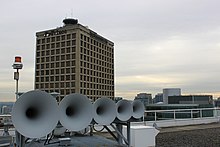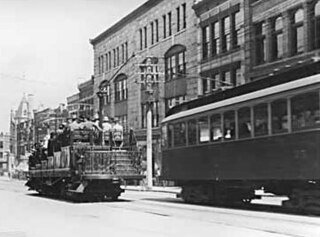
The British Columbia Electric Railway (BCER) was a historic railway which operated in southwestern British Columbia, Canada. Originally the parent company for, and later a division of, BC Electric Company, the BCER assumed control of existing streetcar and interurban lines in southwestern British Columbia in 1897, and operated the electric railway systems in the region until the last interurban service was discontinued in 1958. During and after the streetcar era, BC Electric also ran bus and trolleybus systems in Greater Vancouver and bus service in Greater Victoria; these systems subsequently became part of BC Transit, and the routes in Greater Vancouver eventually came under the control of TransLink. Trolley buses still run in the City of Vancouver with one line extending into Burnaby.

Empire Stadium was a multi-purpose stadium that stood at the Pacific National Exhibition site at Hastings Park in Vancouver, British Columbia, Canada. Track and field and Canadian football, as well as soccer, rugby and musical events, were held at the stadium. The stadium was originally constructed for the 1954 British Empire and Commonwealth Games. The stadium hosted both Elvis Presley and The Beatles. It saw most of its use as the home of the BC Lions of the CFL from 1954 to 1982, in which the venue also played host to the first Grey Cup game held west of Ontario in 1955. Empire Stadium also hosted the Grey Cup game in 1958, 1960, 1963, 1966, 1971, and 1974; seven times in total.

Horseshoe Bay is a community of about 1,000 permanent residents in West Vancouver, in the Canadian province of British Columbia. Situated on the western tip of West Vancouver at the entrance to Howe Sound, the village marks the western end of Highway 1 on mainland British Columbia. It also serves as the southern end of the Sea-to-Sky Highway, with Lions Bay just 15 minutes north.

Canada Place, co-named Komagata Maru Place, is a building situated on the Burrard Inlet in Vancouver, British Columbia, Canada. It is home to the Vancouver Convention Centre, the Pan Pacific Vancouver Hotel, the Vancouver World Trade Centre, and the virtual flight experience Flyover in Vancouver. The building's exterior is covered by fabric roofs resembling sails. It is also the main cruise ship passenger terminal for the region, where cruises to Alaska originate. The building was designed by architects Zeidler Roberts Partnership in joint venture with Musson Cattell Mackey Partnership and DA Architects + Planners.

The Musqueam Nation is a First Nation whose traditional territory encompasses the western half of what is now Greater Vancouver, in British Columbia, Canada. It is governed by a band council and is known officially as the Musqueam Indian Band under the Indian Act. "Musqueam" is an anglicization of the Hunquminum name xʷməθkʷəy̓əm, which means "place of the river grass" or "place where the river grass grows".
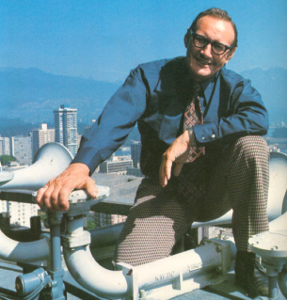
Robert Swanson (1905–1994) was a Canadian researcher and developer, and is credited with the invention of the first five and six-chime air horns for use on locomotives. Swanson had worked as the chief engineer of a company called Victoria Lumber Manufacturing in the 1920s, when he developed a hobby for making steam whistles for locomotives. Eventually, Swanson designed and built a large steam whistle for the mill where he worked. He also built the Heritage Horns that were on the old BC Hydro building that play the first four chords of "O Canada" at noon every day. The horns are now on the roof of the Pan Pacific hotel at Canada Place.

Roberts Bank is home to a twin-terminal port facility located on the mainland coastline of the Strait of Georgia in Delta, British Columbia, Canada. Opened in 1970 with Westshore Terminals as its only tenant, Roberts Bank was expanded in 1983–84, and in June 1997 opened a second terminal, the GCT Deltaport container facility.
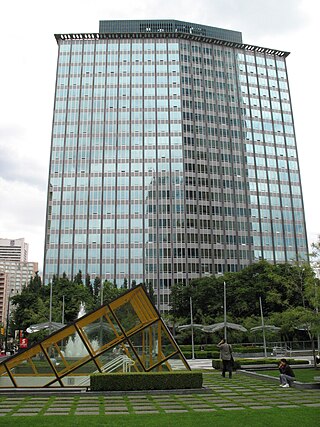
The BC Electric Building is a 22-storey office tower in Vancouver, British Columbia. The building was constructed as the headquarters of the BC Electric Company and was designed by Thompson Berwick & Pratt. The project's design architect was Charles Edward Pratt, who based the lozenge-shaped tower off the unbuilt Back Bay Center in Boston. In 1995 the building was converted from offices to residences and renamed the Electra.

Renfrew–Collingwood is a large neighbourhood that lies on the eastern side of Vancouver, British Columbia, Canada, on its boundary with Burnaby and encompassing an area that was one of the earlier developed regions of the city. It is a diverse area that includes a substantial business community in several areas, as well as some of the fastest-growing residential sectors of Vancouver. In 2011, the neighbourhood had a population of 50,500, 38.4% of whom claim Chinese as their first language.

South Cambie is a neighbourhood in the city of Vancouver, British Columbia, Canada, that is generally considered one of the smallest neighbourhoods in the city, both in size and in population. It is wedged between one of the city's largest parks and the upscale neighbourhood of Shaughnessy, and is known for a large cluster of medical facilities.

The Hotel Vancouver, the second of three by that name, was a 15 story (77m) Italian Renaissance style hotel built in 1916 by the Canadian Pacific Railway (CPR). The architect was Francis S. Swales.
Gambier Island is an island located in Howe Sound near Vancouver, British Columbia. It is about 17,049 acres in size and is located about 10 kilometres north of the Horseshoe Bay community and ferry terminal in westernmost West Vancouver.

Victoria Harbour is a harbour, seaport, and seaplane airport in the Canadian city of Victoria, British Columbia. It serves as a cruise ship and ferry destination for tourists and visitors to the city and Vancouver Island. It is both a port of entry and an airport of entry for general aviation. Historically it was a shipbuilding and commercial fishing centre. While the Inner Harbour is fully within the City of Victoria, separating the city's downtown on its east side from the Victoria West neighbourhood, the Upper Harbour serves as the boundary between the City of Victoria and the district municipality of Esquimalt. The inner reaches are also bordered by the district of Saanich and the town of View Royal. Victoria is a federal "public harbour" as defined by Transport Canada. Several port facilities in the harbour are overseen and developed by the Greater Victoria Harbour Authority, however the harbour master's position is with Transport Canada.

Anvil Island is the third-largest of the islands in Howe Sound, British Columbia, Canada, and the northernmost of the major islands in that sound. It is part of West Howe Sound, Electoral Area F within the Sunshine Coast Regional District (SCRD) on the Sunshine Coast.

The Hillcrest Centre is a community centre with ice hockey, curling rinks, and an aquatics facility, located at Hillcrest Park in Vancouver, British Columbia, Canada. Construction started in March 2007; it hosted the 2009 World Junior Curling Championships prior to the Olympics. During the 2010 Olympics, it was named the Vancouver Olympic/Paralympic Centre and had a capacity of 6,000 people to host curling at the 2010 Winter Olympics; for the 2010 Paralympics, it hosted the Wheelchair Curling event.
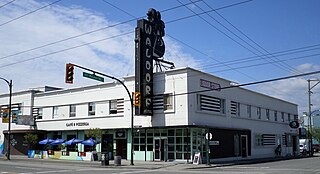
The Hotel at the Waldorf is a boutique hotel in Vancouver, British Columbia, Canada. The hotel was established in 1947 and was one of the most renowned tiki-themed hotels in North America. In 2010, Thomas Anselmi and Ernesto Gomez took over operations and the hotel was renovated into a boutique hotel. The building was home to one of Vancouver's most popular music venues until January 2013 when it was sold to Solterra with plans to rezone the property and make way for condominiums. There was a public outcry to save the land, building and cultural institution that included a petition that received 23,000 signatures. In response, Vancouver mayor Gregor Robertson issued a public statement decrying the loss, which critics denounced as a "sentimental bid for hipster votes."
Concord Pacific Place is "Canada's biggest master-planned urban community" and is projected to be North America's largest in terms of occupants and area when completed. It is located in Vancouver, British Columbia, on the north shore of False Creek. The area was formerly the rail yards of the Canadian Pacific Railway, and was redeveloped into the main site of the 1986 World Exposition.
The King Edward VII Memorial Fountain is a fountain in Vancouver, British Columbia, Canada. Next To The Vancouver Art Gallery,

The Marpole Midden, also known by archaeologists as the Great Fraser Midden or Eburne site, is a 4000-year-old midden near the mouth of the Fraser River, in the Marpole neighbourhood of Vancouver, British Columbia. The site was the location of the ancient Musqueam village of c̓əsnaʔəm and a sacred burial ground.
The Listel Hotel is a hotel located in the downtown area of the Canadian city of Vancouver, British Columbia


